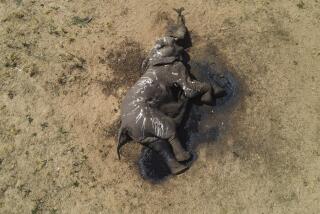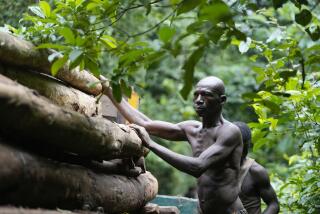Cattle Grazing Threatens Key African Water Source
- Share via
NANYUKI, Kenya — After leaving a trail of cattle skeletons across the plains of northern Kenya over the last six months, David Lenakula has found pasture for his herd on the slopes of his country’s highest mountain.
But it’s cold on Mt. Kenya, and the bones continue to pile up. “I lost three head of cattle this morning,” Lenakula said.
The Masai tribesman is one of thousands of nomadic herders who are grazing nearly 13,500 emaciated cattle and 5,000 sheep and goats in the forests around the mountain, even though the region has always been off-limits to livestock and was pronounced a World Heritage Site in 1997.
A severe drought has devastated Kenya’s livestock and denuded its plains. Herders have moved not only to the mountains but to wherever else they can find grass, including the comfortable residential neighborhoods in Kenya’s capital, Nairobi.
A couple of Masai in red-checkered cloaks even drove their cattle along State House Road by the residence of President Daniel Arap Moi, where the grass is enticingly green. But they moved on when armed sentries signaled disapproval.
Mt. Kenya is the country’s most important water catchment area, and the Kenyan Wildlife Service says the herds are jeopardizing its fragile ecosystem.
The herdsmen say they would gladly leave but have nowhere to go.
“We are grass seekers, and we can only find it here,” Lenakula said.
He says he walked 150 miles to find food and water for his cattle. To find pasture elsewhere, he will wait for the short rains normally due from October through November.
But Nehemiah Rotich, director of the wildlife service, is sending in armed rangers to patrol the forest, saying the drought does not justify herders destroying the environment.
The animals feed voraciously, stripping the land, which contains 882 plant species, 81 of them found only in the 524 square miles of natural forest around Mt. Kenya.
At 17,000 feet, Mt. Kenya is the highest in Africa after Mt. Kilimanjaro in neighboring Tanzania.
Its perpetual snowcap attracts climbers from around the world. Its forests are home to cedar, wild olive, rosewood and camphor trees, and shelter elephants, buffalo, leopards and black rhinos. The state owns plantations of trees like cypress and sells them to timber merchants.
The incursion by the herders that began in early June is the latest human activity to cause widespread damage to the forests.
Last year an aerial survey of the forests led to a chilling conclusion: They were threatened by fires set for legal and illegal farming, grazing, logging and marijuana cultivation.
Now that two rainy seasons have failed, concern about the mountain’s role as a water source is growing, and the effects are being felt by households in Nairobi, 80 miles to the southwest. Less water means less flow in the Tana, Kenya’s largest river, whose six hydroelectric plants generate most of the country’s power.
In the past, the forest land and the plants on the mountain stored water during the rainy season and then slowly released it during the dry season, so that the rivers flowed year-round.
But drought and poor management have weakened the flows, and electricity is being rationed nationwide. The Tana also feeds three irrigation projects that meet Kenya’s rice needs.
Another major river, the Ewaso Ng’iro, draws water from the mountain and runs north through semiarid countryside before draining underground.
“What used to be permanent rivers, like Ewaso Ng’iro, are now becoming seasonal for the first time in history,” says Bongo Woodley, Mt. Kenya National Park’s senior game warden.
More to Read
Sign up for Essential California
The most important California stories and recommendations in your inbox every morning.
You may occasionally receive promotional content from the Los Angeles Times.













